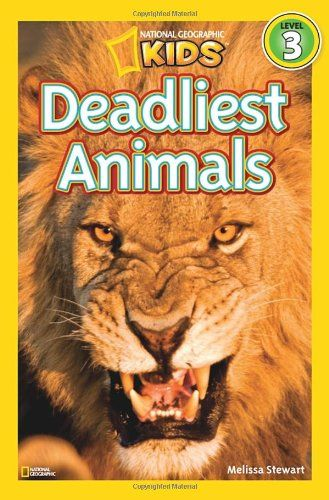Deadliest Animals by Melissa Stewart
Stewart, Melissa. Deadliest Animals. New York: National Geographic Children's Books , 2011.
Lexile Level: 940
Grades: 3-5
Fountas and Pinnell: Level P
Summary: This is an informational text book about the world's most dangerous animals. With awesome illustrations and factual information students will read about over twelve species such as sharks, snakes, jellyfish and more. These creatures are among the most threatening and interesting in the world!
Learning activity for the book:
Students will read this book and learn about Text Features through this slideshow. Students will then use this text to identify the text feature and analyze what new information they learned as a result of the text feature. They will fill out this Text Feature Scavenger Hunt graphic organizer. Students need to find and analyze 5 or more different text features on their graphic organizers.
When students have completed their scavenger hunts, they will reflect on their learning by responding to a Text Features Blog post in which they will explain their overall learning and process with this skills in how confident they feel using graphic sources and what areas they might need help with.
Learning Goal: Students will be able to identify and interpret text features in informational text in order to learn new information about what they are reading.
Learning Objectives:
Students will be able to connect and analyze 5 different graphic sources in a nonfiction text and apply how those features helps them to better understand what their reading (Cognitive).
Students will synthesize and evaluate their learning about graphic sources by creating a blog as a self reflective exit ticket (Psychomotor, Affective)
Learning Objectives:
Students will be able to connect and analyze 5 different graphic sources in a nonfiction text and apply how those features helps them to better understand what their reading (Cognitive).
Students will synthesize and evaluate their learning about graphic sources by creating a blog as a self reflective exit ticket (Psychomotor, Affective)
Learning Standards:
CC Standards: Reading Literature:
Integration of Knowledge and Ideas:
R.L.4.7- Make connections between the text of a story and a visual or oral presentation of the text, identifying where each version reflects specific descriptions and directions in the text.
Reading Informational Text:
Integration of Knowledge and Ideas:
R.I. 4.7- Interpret information visually (charts, maps, diagrams, timelines) and explain how the information contributes to an understanding of the text in which is appears.
Information Fluency Continuum:
4.10 Identifies own strengths and sets goals for improvement.
American Association School Library:
2.4.1 Determine how to act on information (accept, reject, modify).
2.4.3 Recognize new knowledge and understanding.
No comments:
Post a Comment